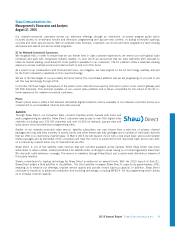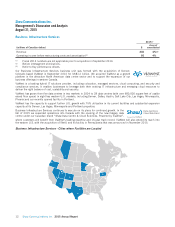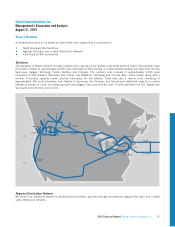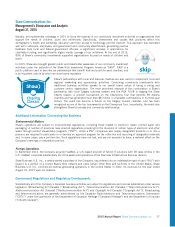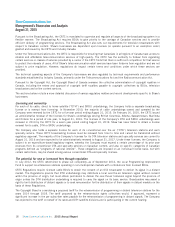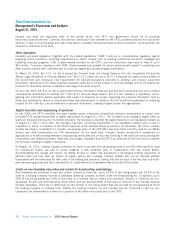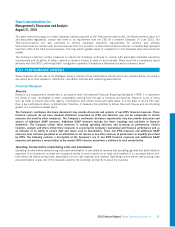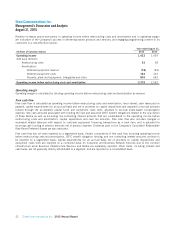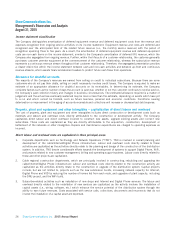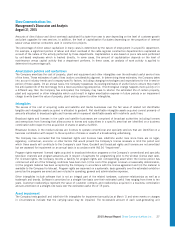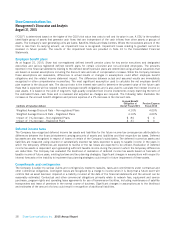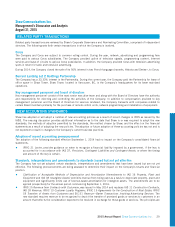Shaw 2015 Annual Report Download - page 21
Download and view the complete annual report
Please find page 21 of the 2015 Shaw annual report below. You can navigate through the pages in the report by either clicking on the pages listed below, or by using the keyword search tool below to find specific information within the annual report.
Shaw Communications Inc.
Management’s Discussion and Analysis
August 31, 2015
Let’s Talk TV regulatory framework
In October 2013, the CRTC initiated a “conversation with Canadians about the future of television”, commonly referred to as
“Let’s Talk TV”, which led to a major review of the regulatory and policy framework for the Canadian television broadcasting
system and a series of policy decisions in 2015. The new policy framework will require licensed BDUs to offer a $25 entry-level
service offering (basic service) by March 2016. BDUs will be allowed to offer a larger “first-tier offering”. By March 2016, all
discretionary services (not offered on the basic service) must be offered either on a standalone basis or in packages of up to ten
programming services. On or after December 1, 2016, these services must be offered both on a standalone basis and in
packages of up to ten programming services. These changes will significantly impact BDUs’ customer management systems and
may create market uncertainty for both BDUs and programming services. Additional uncertainty may result from the elimination
of genre protection and changes to access rules. The CRTC has made new regulations, which will come into force on
December 1, 2015, governing simultaneous substitution. These new regulations may result in rebates (BDU errors) or loss of
privileges (broadcaster errors). The CRTC has also introduced new codes governing the relationship between BDUs and their
customers, the “Television Service Provider Code of Conduct”, and the relationship between distributors and programmers, the
“Wholesale Code”. The CRTC has, as well, prohibited 30-day cancellation policies for voice, Internet and broadcasting
distribution services. A proceeding on local and community television may result in changes to the policies and funding regimes
governing community channels and local television stations.
Access rights
For its network Shaw requires access to support structures, such as poles, strand and conduits of telecommunication carriers
and electric utilities, in order to deploy cable facilities. Under the Telecommunications Act the CRTC has jurisdiction over
support structures of telecommunication carriers, including rates for third party use. The CRTC’s jurisdiction does not extend to
electrical utility support structures, which are regulated by provincial utility authorities. For its network Shaw also requires
access to construct facilities in roadways and other public places. Under the Telecommunications Act, Shaw may do so with the
consent of the municipality.
New media and Internet
The CRTC has issued a digital media exemption order requiring that Internet-based and mobile point-to-point broadcasting
services not offer television programming on an exclusive or preferential basis in a manner that depends on subscription to a
specific mobile or retail Internet service and not confer an undue preference or disadvantage.
The CRTC has decided to not impose a levy on the revenue of exempt digital media undertakings to support Canadian new
media content and instead issued an exemption order for VOD services offered both by licensed BDUs and direct to consumer
over the Internet, such as shomi. These services benefit from virtually the same flexibility as services operating under the digital
media exemption order (including the ability to offer exclusive programming) and are subject to similar restrictions on offering a
service on an exclusive or preferential basis or conferring an undue preference or disadvantage.
Third Party Internet Access
Shaw is mandated by the CRTC to allow independent ISPs to provide Internet services at premises served by Shaw’s network
(“Third Party Internet Access” or “TPIA”). In 2014-2015, the CRTC completed a review of the wholesale wireline
telecommunications policy framework, including TPIA, and extended mandated wholesale access services to include fibre-to-
the-premise facilities, which will coincide with a shift to a new disaggregated wholesale Internet access service to be phased in
over the next three years. The new disaggregated model will increase the number of interconnection points within the networks
of wholesale providers, such as Shaw. Depending on how the model is implemented, Shaw may need to adjust its network
design and configuration.
Within the coming year, the CRTC also plans to review the competitor quality of service indicators and the rate rebate plan for
competitors to ensure alignment with the new wholesale services framework. As part of this review, the CRTC may extend
quality of service obligations to providers of wholesale Internet services.
CRTC basic services proceeding
In April 2015, the CRTC initiated a comprehensive review of basic telecommunications services to determine what services
(e.g. telephone and broadband) are required by all Canadians to fully participate in the digital economy, whether there should
be changes to the subsidy regime and national contribution mechanism to fund expansion or adoption of broadband services in
2015 Annual Report Shaw Communications Inc. 19


